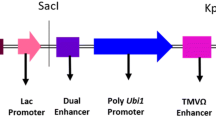Abstract
A crystal δ-endotoxin gene ofBacillus thuringiensis subsp.tenebrionis (B.t.t.) encoding a coleopteran insect-specific toxin was used to construct a chimeric gene which expressed the toxin in plant cells. Via anAgrobacterium tumefaciens binary vector system, the toxin gene was transferred into tomato cells. From leaf disks recombinant plants were regenerated. Hybridization experiments demonstrated that these plants synthesized toxin-specific mRNA of the expected size. Transgenic tomato plants with the chimericB.t.t. toxin gene contained a 74 kDa protein which cross-reacted with toxin antibodies. The expression caused a significant insecticidal activity of the transgenic tomato plants against Colorado potato beetle larvae.
Similar content being viewed by others
References
Aronson AI, Beckman W, Dunn P:Bacillus thuringiensis and related insect pathogens. Microbiol Rev 50: 1–24 (1986).
Barton KA, Whiteley HR, Yang NS:Bacillus thuringiensis δ-endotoxin expressed in transgenicNicotiana tabacum provides resistance to Lepidopteran insects. Plant Physiol 85: 1103–1109 (1987).
Barton KA, Miller MJ: Production ofBacillus thuringiensis insecticidal proteins in plants. In: Kung SD, Wu R (eds) Transgenic Plants, vol. 1, pp. 297–315. Academic Press, New York (1993).
Chirgwin JM, Przybyla AE, Macdonald RI, Rutter WJ: Isolation of biologically active ribonucleic acid from sources enriched in ribonuclease. Biochemistry 18: 5294–5299 (1979).
Ely S: The engineering of plants to expressBacillus thuringiensis δ-endotoxins. In: Entwistle PF, Cory JS, Higgs S (eds)Bacillus thuringiensis: An Environmental Biopesticide: Theory and practice, pp. 105–124. John Wiley, West Sussex (1993).
Fischhoff D, Bowdish KS, Perlak FJ, Marrone PG, McCormick SM, Niedermayer JG, Dean DA, Kusano-Kretzmer K, Mayer EJ, Rochester DE, Rogers SG, Fraley RT: Insect tolerant transgenic tomato plants. Bio/technology 5: 807–813 (1987).
Gelernter W, Schwab GE: Transgenic bacteria, viruses, alge and other microorganisms asBacillus thuringiensis toxin delivery systems. In: Entwistle PF, Cory JS, Higgs S (eds),Bacillus thuringiensis: An Environmental Biopesticide: Theory and practice, pp. 89–104, John Wiley, West Sussex (1993).
Hahlbrock K, Gross P, Colling CH, Scheel D: Molecular basis of plant defense responses to fungal infections. In: Herrman RG, Larkins BA (eds) Plant Molecular Biology vol. 2, pp. 147–151, Plenum Press, New York/ London (1991).
Hoefgen R, Willmitzer L: Biochemical and genetic analysis of different patatin isoforms expressed in various organs of potato (Solanum tuberosum). Plant Sci 66: 221–230 (1990).
Hoefte H, Whiteley HR: Insecticidal crystal proteins ofBacillus thuringiensis. Microbiol Rev 53: 242–255 (1989).
Hoekema A, Hirsch PR, Hooykaas PJJ, Schilperoort RA: Abinary plant vector strategy based on separation ofvir- and T-region of theAgrobacterium tumefaciens Tiplasmid. Nature 303: 179–180 (1983).
Jones JDG, Dunsmuir P, Bedbrook J: High level expression of introduced chimeric genes in regenerated transformed plants. EMBO J 4: 2411–2418 (1985).
Koornneef M, van Diepen JAM, Hanhart CJ, Kieboomde Waart AC, Martinelli L: Chromosomal instability in cell- and tissue cultures of tomato haploids and diploids. Euphytica 43: 179–186 (1989).
Krieg A, Huger AM, Langenbruch GA, Schnetter W:Bacillus thuringiensis var.tenebrionis: ein neuer, gegenuber Larven von Coleopteren Wirksamer Pathotyp. Z angew Entomol 96: 500–508 (1983).
Krieg A, Schnetter W, Huger AM, Langenbruch GA:Bacillus thuringiensis subsp.tenebrionis, strain BI 256-82: a third pathotype within the H-serotype 8a8b system. Appl Microbiol 9: 138–141 (1987).
Kung SD: Introduction: from hybrids plants to transgenic plants. In: Kung SD, Wu R (eds) Transgenic Plants, vol. 1, pp. 1–12. Academic Press, New York (1993).
McCormick SM, Niedermeyer J, Fry J, Barnason A, Horsch R, Fraley R: Leaf-disk transformation of cultivated tomato (L. esculentum) usingAgrobacterium tumefaciens. Plant Cell Rep 5: 81–84 (1986).
McPherson SA, Perlak FJ, Fuchs RL, Marrone PG, Lavrik PB, Fishhoff DA: Characterization of the coleopteran-specific protein gene ofBacillus thuringiensis var.tenebrionis. Bio/technology 6: 61–66 (1988).
Murashige T, Skoog F: A revised medium for rapid growth and bioassays with tobacco tissue cultures. Physiol Plant 15: 473–497 (1962).
Odell JT, Nagy F, Chua NH: Identification of DNA sequences required for activity of the cauliflower mosaic virus 35S promoter. Nature 313: 810–812 (1985).
Rhim SL, Jahn N, Schnetter W, Geider K: Heterologous expression of a mutated toxin gene fromB. thuringiensis ssp.tenebrionis. FEMS Microbiol Lett 66: 95–100 (1990).
Rogers SO, Bendich AJ: Extraction of DNA from plant tissues. In: Gelvin SB, Schilperoort RA (ed) Plant Molecular Biology Manual, A6: 1–10. Kluwer Academic Publishers, Dordrecht (1988).
Sambrook J, Fritsch EF, Maniatis T: Molecular Cloning: A Laboratory Manual. Cold Spring Harbor Laboratory, Cold Spring Harbor, NY (1989).
Sekar V, Thomson DV, Maroney MJ, Bookland RG, Adang MJ: Molecular cloning and characterization of the insecticidal crystal protein gene ofBacillus thuringiensis var.tenebrionis. Proc Natl Acad Sci USA 84: 7036–7040 (1987).
Simon R, Priefer U, Puehler A: Vector plasmids for in-vivo and in-vitro manipulations of gram-negative bacteria. In: Puehler A (ed) Molecular Genetics of the Bacterial-Plant Interaction, pp. 98–106. Springer-Verlag, Berlin/Heidelberg (1983).
Smith CM: Plant Resistance to Insects. John Wiley, New York (1989).
Thorne L, Garduno F, Thompson T, Decker D, Zounes M, Wild M, Walfield AM, Pollock TJ: Structural similarity between the Lepidoptera- and Diptera-specific insecticidal endotoxin genes ofBacillus thuringiensis subsp.kurstaki andisralensis. J Bact 166: 801–811 (1986).
Vaeck M, Reynaerts A, Hoefte H, Jansens S, De Beuckeleer M, Dean C, Zabeau M, Van Montagu M, Leemans J: Transgenic plants protected from insect attack. Nature 328 (2): 33–37 (1987).
Author information
Authors and Affiliations
Rights and permissions
About this article
Cite this article
Rhim, SL., Cho, HJ., Kim, BD. et al. Development of insect resistance in tomato plants expressing the δ-endotoxin gene ofBacillus thuringiensis subsp.tenebrionis . Mol Breeding 1, 229–236 (1995). https://doi.org/10.1007/BF02277423
Received:
Accepted:
Issue Date:
DOI: https://doi.org/10.1007/BF02277423




